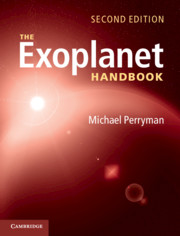Book contents
- Frontmatter
- Contents
- Preface to the Second Edition
- 1 Introduction
- 2 Radial velocities
- 3 Astrometry
- 4 Timing
- 5 Microlensing
- 6 Transits
- 7 Imaging
- 8 Host stars
- 9 Brown dwarfs and free-floating planets
- 10 Formation and evolution
- 11 Interiors and atmospheres
- 12 The solar system
- Appendix A Numerical quantities
- Appendix B Notation and acronyms
- Appendix C Radial velocity exoplanets
- Appendix D Transiting exoplanets
- Appendix E Lensing exoplanets
- Appendix F Imaging exoplanets
- References
- Subject index
- Object index
11 - Interiors and atmospheres
Published online by Cambridge University Press: 25 August 2018
- Frontmatter
- Contents
- Preface to the Second Edition
- 1 Introduction
- 2 Radial velocities
- 3 Astrometry
- 4 Timing
- 5 Microlensing
- 6 Transits
- 7 Imaging
- 8 Host stars
- 9 Brown dwarfs and free-floating planets
- 10 Formation and evolution
- 11 Interiors and atmospheres
- 12 The solar system
- Appendix A Numerical quantities
- Appendix B Notation and acronyms
- Appendix C Radial velocity exoplanets
- Appendix D Transiting exoplanets
- Appendix E Lensing exoplanets
- Appendix F Imaging exoplanets
- References
- Subject index
- Object index
Summary
ASIGNIFICANT ADVANCE IN THE KNOWLEDGE of exoplanet interiors and atmospheres was made possible with the discovery of transiting exoplanets. Densities derived from their masses and radii are providing some indications of their interior structure and composition, while optical and infrared transit and eclipse spectroscopy are yielding the first insights into the atmospheric composition, atmospheric dynamics, and thermal transport processes of hot Jupiters. All of this has been substantially facilitated by the knowledge of interiors and atmospheres of the solar system planets and satellites acquired over the last half century.
The insights that can be expected from improved photometric or spectroscopic measurements, for example, with JWST due for launch in 2020, are substantial. For planets inferred to be in the ‘habitable zone’ of their host star, where liquid water is expected to be supported, diagnostics can hope to identify detailed atmospheric compositions, including signatures that may be attributable to primitive or more advanced life forms. These advances are providing a new impetus to searches for life, and even for intelligent life, and the grand question of whether life is extremely common, or extremely rare, elsewhere in the Universe.
Introduction
Physical models of exoplanets span two extreme classes of object, and potentially much in between: the lowmass high-density ‘solid’ planets dominated by metallic cores and silicate-rich and/or ice-rich mantles, and the high-mass low-density gas giants dominated by their massive accreted H/He envelopes.
For the gas-rich giants, models of their interiors and models of their atmospheres are closely connected, and the most recent atmospheric models couple their emergent flux with their assembly by core accretion. Models of their interiors predict bulk properties such as the pressure–temperature relation, and their radii as a function of mass. For close-in, highly irradiated gas giants, the additional external heat source has a significant effect on the pressure–temperature structure of the outer atmosphere. Combined with inferences on their probable bulk chemical composition, atmospheric models also predict colours and spectral features arising from specific atomic and molecular species.
- Type
- Chapter
- Information
- The Exoplanet Handbook , pp. 559 - 648Publisher: Cambridge University PressPrint publication year: 2018



